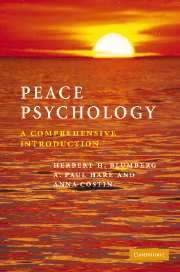Book contents
- Frontmatter
- Contents
- Preface
- Acknowledgements
- The scope, structure and content of this book
- Part I Introduction
- Part II Interdisciplinary practice
- 2 Government policy and international relations
- 3 Education
- 4 The feminist approach
- 5 Philosophy, ethics and religion
- Part III Primary psychological topics
- Part IV Core topics in peace and environmental studies
- Part V Terrorism
- References
- Index
3 - Education
Published online by Cambridge University Press: 05 June 2012
- Frontmatter
- Contents
- Preface
- Acknowledgements
- The scope, structure and content of this book
- Part I Introduction
- Part II Interdisciplinary practice
- 2 Government policy and international relations
- 3 Education
- 4 The feminist approach
- 5 Philosophy, ethics and religion
- Part III Primary psychological topics
- Part IV Core topics in peace and environmental studies
- Part V Terrorism
- References
- Index
Summary
Peace education is crucial for transforming the thinking and values of students with regard to social interdependence and social justice, as Coleman and Deutsch (2001: 223) have pointed out. A majority of publications on research about peace education seem concerned mainly with secondary-school level materials though some concentrate on primary school and some on post-secondary and general materials. There are nevertheless a very substantial number of actual college and university courses – as well as those designed for younger ages – that are concerned with peace studies and conflict resolution, including psychological and other aspects (see, for example, the websites listed at the end of this chapter).
Coverage in this chapter is necessarily rather selective. Readers may also wish to consult Bodine and Crawford (1998), Harris and Morrison (2003) and Salomon and Nevo (2002; Christie, 2004).
Pre-secondary level
The few pre-secondary-school studies emphasize the importance of promoting a ‘positive’ peace rather than just the curtailing of violence; this includes raising consciousness about peace and discussing appropriate problem-solving (Tabachnick, 1990; see also, C. E. Johnson and Templeton, 1999; Vandenplas-Holper, 1990). The importance of a comprehensive programme has been emphasized, even if some features – such as using children's stories to promote peace in the classroom – are more prominent only in particular instances (V. G. Morris, Taylor and Wilson, 2000).
- Type
- Chapter
- Information
- Peace PsychologyA Comprehensive Introduction, pp. 31 - 36Publisher: Cambridge University PressPrint publication year: 2006
- 1
- Cited by

